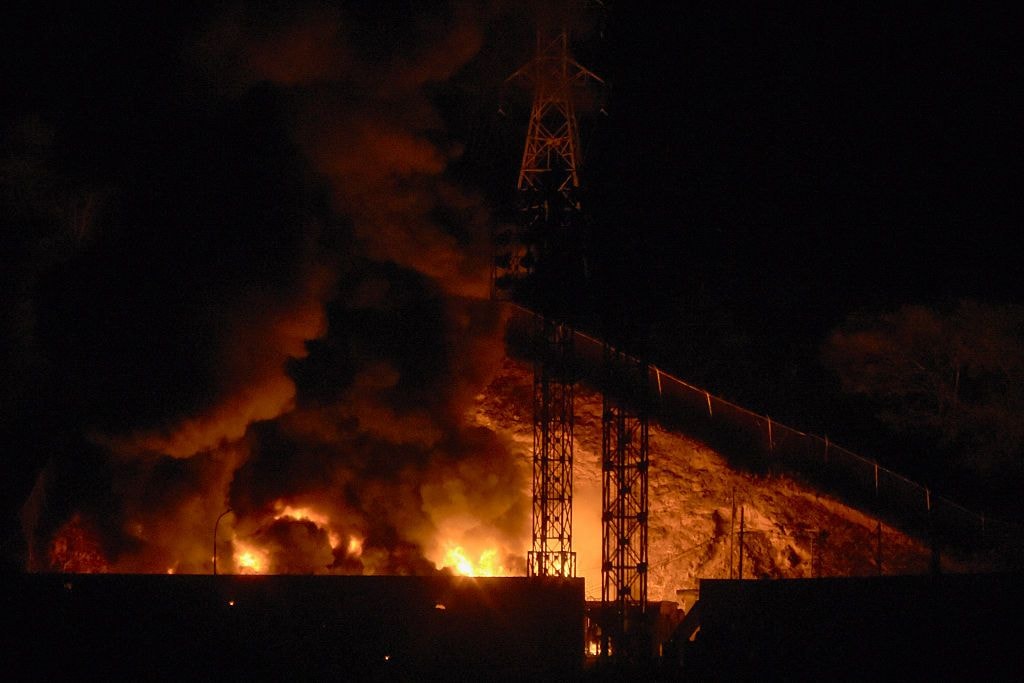
US sense of urgency questioned as billions in Ukraine aid hangs in balance
US and Ukraine officials assure that $6 billion aid will flow but Kyiv is nervous as the memory is still fresh of a seven-month delay in getting a $61 billion weapons package approved.
US President Joe Biden speaks alongside Ukraine's President Volodymyr Zelensky (R) during the Ukraine Compact initiative on the sidelines of the NATO Summit at the Walter E. Washington Convention Center in Washington, DC, US on July 11, 2024. (Brendan Smialowski / AFP via Getty Images)
News that $6 billion worth of outstanding U.S. military aid to Ukraine could expire by the end of September if Congress doesn’t take urgent action is unsettling some in Kyiv, where the painful memory of a larger package delay that led to battlefield losses remains fresh.
Delivering the $6 billion in additional U.S. aid depends on Congress extending the Pentagon’s authority to send weapons from its stockpiles to Ukraine. It is part of a larger $61 billion package approved last April after a seven-month delay, despite being critical to helping Kyiv fight off Russia’s full-scale invasion.
U.S. President Joe Biden’s administration has asked Congress to include the $6 billion, provided via the Presidential Drawdown Authority program (PDA), in any continuing resolution lawmakers may pass before the end of the fiscal year on Sept. 30 to fund the federal government and — yet again — prevent a shutdown.
U.S. officials said they hope to have the authority extended for another year, but the Defense Department is looking into other options if that effort fails.
It’s unclear why the $6 billion in military aid was not provided earlier, given the urgent needs of Ukraine’s armed forces in repelling Russia’s full-scale invasion, nor what weaponry it could entail. Multiple government sources in Ukraine and the U.S. declined to discuss the issue in detail.
The $6 billion is part of the $61 billion package approved in April, a congressional advisor who agreed to speak on condition of anonymity to discuss details of the aid told the Kyiv Independent.
The advisor added that the delay in disbursing it due to absorption capacity issues, domestic US stock constraints, and a “constant flexibility issue with each withdrawal” in a situation where the U.S. adapts to Ukraine’s needs.
Ukraine’s Defense Ministry told the Kyiv Independent that the weapons and equipment for the full amount were not yet sent to Ukraine due to “the lack of the necessary weapons in the Pentagon's warehouses.” The ministry didn’t specify which weapons were requested but assured that “there is no reason to believe that these $6 billion will ‘burn out.’"

“As far as sources in Congress tell me, the situation is under control, and the money won’t be lost – that’s the main thing,” David Arakhamia, head of President Volodymyr Zelensky's Servant of the People faction in parliament, told the Kyiv Independent.
But the episode appears to be the latest in which Ukraine’s top Western ally is drip-feeding weaponry supplies to Ukraine, on purpose or due to a lack of urgency, in an existential war waged by Russia which Zelensky’s administration has described as “genocidal.”
Addressing the annual Yalta European Strategy forum held in Kyiv on Sept. 13-14, Biden’s national security chief Jake Sullivan spoke of plans to announce a significant assistance package for Ukraine by the end of this month.
Yet the sense of many in Kyiv, which is shared with some European allies, is that while the U.S. has stepped up military assistance sharply, it is still not providing sufficient amounts and fast enough to help Ukraine decisively win the war.
“It is crucial that all states, and especially those like the United States, implement our agreements really promptly,” Zelensky said in his Sept. 14 evening address to the nation.
“Every delay in military packages has its negative consequences at the front. Every truly timely, fast delivery has a positive impact. I briefed the Congressmen on the current situation and the prospects,” he added.
Zelensky, who is to meet with Biden later this month in the U.S. for talks on future assistance and lifting of restrictions on using Western missiles to strike Russian territory, expressed the same frustration one day earlier about promised but not yet delivered military weaponry from Western allies without directly mentioning the $6 billion U.S. aid.
As he addressed the annual Yalta European Strategy meeting in Kyiv, Zelensky said that it’s “really difficult to hear the same answer every time – ‘we are working on it.’”
He also said that the talks on equipping Ukrainian frontline brigades with the West’s help had been ongoing “for months,” with the same vague answer from some “leaders and states that have made responsible commitments” earlier.
“Frankly, we are still far from fully implementing what we have agreed on a long time ago,” Zelensky added.
Washington’s delay from late 2023 into this spring in passing a $61 billion aid package for Ukraine contributed to the deteriorating situation on the eastern Donbas frontline, where Russia’s grinding offensive made advances.
In almost seven months of political infighting in the U.S. before the aid was allocated, Ukraine lost some key territories, including the city of Avdiivka, and suffered significant damage to its energy infrastructure around the country due to the lack of air defense systems to counter Russian missile strikes.
The legislation was first opposed but later approved by Republican legislators loyal to Donald Trump, who seeks to return as president in a Nov. 5 election against Vice President Kamala Harris.
Sense of urgency often lost despite sky-high stakes
The risk of yet another delay in crucial assistance from Ukraine’s top Western ally comes as the country’s Armed Forces, outgunned and outmanned, continue to battle Russia’s full-scale invasion two and a half years into the bloodiest conflict in Europe since World War II.
And as Zelensky continues to press the U.S. and other Western allies for permission to use their long-range missile for strikes into Russian territory.
“We have seen this pattern time and again — delays in the allocation of funding, delays in deployment, and delays in deliveries,” Tymofiy Mylovanov, president of the Kyiv School of Economics and former advisor to Zelensky’s administration, told the Kyiv Independent.
“The sense of urgency is often lost in the Western capitals, but this directly translates into lives lost and an unsafer world. Simply irresponsible," Mylovanov said.
The Biden administration and some European leaders have in the past years expressed fears that arming Ukraine too much — in essence, giving it enough weapons to win the war — could provoke Russia to escalate and potentially use nuclear weapons.
Russian President Vladimir Putin and others in his regime have made such threats. Repeating them recently, they said that the West would be at war with Russia if it allowed its long-range missiles to be used by Ukraine for strikes deep inside Russia.
Ukraine, which most recently seized a patch of Russian territory with the Kursk incursion, claims such threats are empty.
“Putin's threats do not work. Ukraine’s allies should not fall for them,” Ukraine’s Foreign Minister Andrii Sybiha said in a Sept. 15 post on X, where he outlined how Russia has during the war repeatedly threatened escalation if Western allies armed Ukraine.
“Putin uses threats to weaken support for Ukraine. Instead, allies should boost it. Lift restrictions. Bolster Ukraine’s long-range strength, air shield, and economic and energy resilience. Fear and inaction only lead to deaths and crises. To restore peace, we need bravery, not fear,” Sybiha added.

Some influential members of both Republican and Democratic parties in the U.S. Congress have called for the Biden administration to lift restrictions on using Western missiles on Russian territory and to further boost long-term military assistance to Ukraine.
They also wish to swiftly resolve the $6 billion aid issue.
“It is highly disappointing that nearly $6 billion of the Presidential Drawdown Authority (PDA) remains untouched as we near the end of the fiscal year,” Republican Rep. Michael McCaul, told the Kyiv Independent.
“The administration must utilize all remaining PDA to provide Ukraine with the capabilities it needs to win this war — just as Congress intended when it provided this authority in the national security supplemental earlier this year,” McCaul added.
Democratic Congressman Jim Costa told the Kyiv Independent, "We are set to work this out," adding that there might be some friction on the new appropriations package, but the issue is a priority.
When asked about the matter by the Kyiv Independent, former U.S. Ambassador to Ukraine William B. Taylor said he was assured by a senior Pentagon official “not to worry” — that the funds would not expire.
“Six billion dollars is serious money… And there are two people in the U.S. government (who know the details of this question) that I talk to all the time… One of them is Laura Cooper, the deputy assistant secretary for defense for arming Ukraine,” Taylor said during an informal press briefing in Kyiv.
Cooper “knows the details of this $6 billion… and she said, ‘Bill, don’t worry.’ And for her to tell me that, I take it,” Taylor said without providing any further details.
‘Dangerous’ delays as rogue states weaponry flows into Russia
But Mylovanov said the pattern of delays and restrictions on the use of weaponry provided "is very dangerous and in fact irresponsible.”
“It was so difficult getting the ($61 billion) supplemental passed. And now there is this bureaucratic (and political?) process that jeopardizes $6 billion,” Mylovanov quipped.
He pointed to uninterrupted missile and other weaponry supplies to Russia from rogue states Iran and North Korea.
"Iran and North Korea don't appear to be constrained by delays, permissions, and bureaucracy when sending weapons to Russia. Nor are they constraining Russia in how it can use their weapons,” Mylovanov said.
The Pentagon is seeking an extension from Congress of PDA authorities beyond the end of the fiscal year, a spokesperson told the Kyiv Independent.
“The Department will continue to provide drawdown packages in the near future," the Pentagon’s statement said.

Publicly, the Pentagon gave similarly nebulous assurances.
“I have no doubt that we are going to use everything we can that's available to us to make sure that we are continuing to provide Ukraine what it needs both in the short term and the long term,” Pentagon spokesperson Sabrina Singh said during a press briefing on Sept. 5.
“We're in this fight with Ukraine for the long haul… So you're going to see us make use of those funds in any way possible.”
Despite Ukraine’s plea to lift restrictions on the use of long-range weapons to defend its cities, Singh said that it would have “very little strategic value”, since the U.S.-provided ATACMS (Army Tactical Missile Systems) couldn’t reach most of the Russian airfields located beyond its 300-kilometers range, according to Pentagon’s intelligence.
Meanwhile, President Zelensky said in his speech on Sept. 13 that without the ability to strike inside Russia, ATACAMS in Ukraine are “pointless.” He added that he discussed the matter with the U.S. Secretary of State Antony Blinken and British Foreign Secretary David Lammy who visited Kyiv recently.
“I hope that after our conversation, there simply cannot be any unanswered questions about why Ukraine needs sufficient long-range capability,” Zelensky said.
Kyiv Independent Deputy Editor-in-Chief Oleksiy Sorokin contributed reporting to this story.














